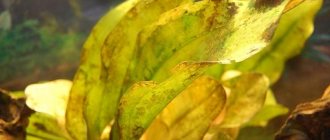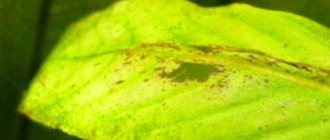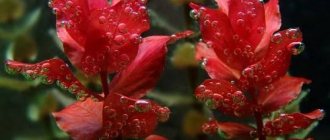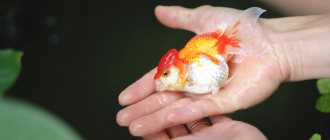Why do the plants in the aquarium turn yellow?
A change in leaf color indicates that the biological balance in the home pond is disturbed.
Plant diseases can be caused by:
- low/intense lighting;
- unreasonably short or long daylight hours;
- inappropriate temperature conditions;
- rare water changes;
- insufficient filtration;
- soil depletion (for plants receiving nutrition from the bottom substrate);
- changes in the chemical composition of the aquatic environment;
- lack of carbon dioxide;
- deficiency or excess of micro- and macroelements;
- the presence of weeds or parasitic algae, herbivorous snails and fish in the aquarium.
If the reason for the appearance of yellow leaves is soil depletion or lack of light, then solving the problem is simple: you need to increase the power of the lamps and the duration of their operation, and lay a fresh layer of fertile soil on the bottom. But most often, diseases occur due to an imbalance of minerals.
Sulfur
Benefits of sulfur for plants
Sulfur is one of the sources for building cell proteins. It is necessary for normal growth and development of the plant. Sulfur is part of amino acids, participates in the formation of enzymes and vitamins, improves the absorption of nitrogen compounds, and is involved in the process of oxygen absorption and CO2 release. Sulfur is required for important metabolic processes and redox reactions, as it is a carrier of hydrogen. Sulfur affects the formation of chlorophyll, promotes enhanced development of plant roots and seed formation. Sulfur is also a molecule of taste and smell.
Sulfur also increases the resistance of crops to low or high temperatures, drought, and radiation. Due to its multifaceted significance, sulfur cannot be replaced by other elements of mineral nutrition.
Sulfur deficiency in plants
Sulfur deficiency occurs extremely rarely. However, a lack of sulfur in plant nutrition leads to a decrease in photosynthesis by 40%!
A lack of sulfur manifests itself as superficial chlorosis (yellowing of leaves) on young leaves and at growing points, because sulfur almost does not move from the lower tiers to the young leaves and is not re-absorbed by the plant. Moreover, sulfur deficiency begins at the base of the leaves and moves to their tips. With a lack of sulfur, small leaves with a light yellowish color are formed on elongated stems, and the growth and development of plants deteriorate. The parts under the leaves may take on a pinkish-red or orange tint. In general, the picture resembles the symptoms of nitrogen deficiency, with the only difference that nitrogen deficiency first appears on the lower old leaves. But unlike nitrogen starvation, during sulfur starvation, plant leaves do not fall off, although they are pale in color.
To eliminate sulfur deficiency, any inorganic and organic nutrients that contain sulfur are suitable. For example, Epsom salts - 1-2 teaspoons per liter of water; garden sulfur (Garden Sulfur), potassium sulfate (Sulfate of Potash), gypsum (Gypsum).
Excess sulfur – how does it manifest itself and how to eliminate it?
With an excess of sulfur, the leaves gradually turn yellow at the edges and shrink, turning inward. Then they turn brown and die. Sometimes the leaves take on a lilac-brown hue rather than yellow. There is a general coarsening of the plants, the leaves become smaller.
General recommendations for eliminating excess sulfur are the same as for excess of any other nutrient. When growing in soil, it is recommended to change the substrate (possibly partially), or wash the substrate with clean water with an adjusted pH. In hydroponics, it is recommended to change the solution to clean water for 2-3 days, then 50% of the concentration recommended by the manufacturer.
Imbalance of macronutrients: consequences for plants
For aquaflora, it is dangerous to change the optimal concentration of macroelements both up and down. The lack of mineral compounds is compensated by precisely calculated doses of appropriate chemicals.
Beginning aquarists are recommended to use ready-made complex fertilizers:
- Tetra Plant Start;
- AQUAYER Udo Ermolaeva MACRO+;
- Plant Elixir, etc.
They contain minerals, growth hormones and root formation stimulants, protect and strengthen plants.
Excess mineral compounds are eliminated by partial or complete water changes, carried out in several stages over 1-2 weeks.
Nitrogen
Plants lack nitrogen.
When nitrogen starvation occurs, the edges, ends and veins of the leaf blades become yellow, young leaves slow down, and old leaves fall off.
There are two ways to increase the nitrogen level in water:
- Reduce the water temperature in the tank by a few degrees. At the same time, you need to ensure that the temperature remains comfortable for the fish living in the aquarium and that they do not die from hypothermia.
- Feed weekly with nitrogen-containing fertilizers or urea at the rate of 5-10 mg per 1 liter of aquarium volume.
In older aquariums the opposite problem often occurs. Excess nitrogen causes thickening of the stems, thickening of the leaves and a change in plant color from light green to dark green.
An excess of nitrate compounds may also be indicated by the rapid proliferation of blue-green algae (threaded algae, flip flops, etc.). To restore biobalance, you need to completely change the water over 15 days in 4-5 steps, rinse the soil, and feed the plants with potassium and phosphorus.
Phosphorus
Phosphorus deficiency is manifested by the following symptoms:
- changing the light shade of leaves to dark;
- curling of leaf plates and young shoots;
- holes, reddish or brown spots on the leaves.
To meet the phosphorus needs of aquaflora, calcium or potassium phosphate should be added every 7-10 days at the rate of 50-500 mg per 100 liters of water.
With an excess of the chemical element, plant shoots quickly turn yellow and shed their leaves.
Lack of phosphorus in aquarium plants.
Sulfur
A sign of sulfur starvation is the acquisition of a reddish or yellow tint by the leaves. The simplest treatment method in this case is to add 1-2 crystals of purified sulfur (available in the form of a yellow powder and sold in pharmacies).
High sulfur content accelerates the aging of plants. To restore balance, you need to temporarily abandon fertilizers containing sulfates.
Chlorine
An increased concentration of chlorine in water leads to the appearance of yellowness in young leaves and a reddish-brown color in old ones. To restore plants, it is useful to add 0.5 g of calcium chloride for every 100 liters of water every 7-10 days.
Excessive chlorine levels are indicated by:
- stopping the growth of aquaflora;
- increased rigidity of green parts of plants;
- leaf shrinkage.
The method of treatment is to reduce the concentration of chlorides and change the water weekly.
Calcium
Calcium deficiency in aquarium plants.
In regions with soft water, aquaflora may experience calcium deficiency, which is manifested by the following symptoms:
- the edges of the leaf blades turn yellow;
- leaves curl;
- the growing points turn black.
To restore chemical balance, the landscape of the aquarium can be decorated with a large hollow shell (previously disinfected) or decorative tuff. Feeding with universal fertilizers with calcium will not be superfluous.
If you use high-hardness tap water to fill the aquarium, the green tissues between the veins of the leaves become covered with white circular spots.
Soft water will help restore health to plants. In addition, mollusk shells or pieces of limestone used for landscaping should be removed from the aquarium.
Potassium
The source of potassium for plants is fresh water and leftover food not eaten by fish. With a lack of macronutrients, the edges of the leaves wither, the surface of the leaf blades becomes covered with yellow spots or holes. Potassium deficiency is treated by adding 1-2 g of potassium for every 100 liters of water. As a top dressing, you can use Nitrophoska fertilizer in granules or complex formulations with a high potassium content.
When the concentration of potassium in water exceeds the norm, plants shoots abnormally elongate and leaves die.
Magnesium
A deficiency of alkaline earth metal leads to the appearance of white or yellow spots between the veins and deformation of the leaf blades. Periodic (every 10-15 days) application of magnesium sulfate MgSO₄ (5-20 mg/l) helps to compensate for the lack of magnesium.
With an excess of macronutrients, young leaves bend and lighten, while old leaves, on the contrary, become dark green. In such cases, it is recommended not to use fertilizers with magnesium, but to use tap water for weekly changes.
Diseases of aquarium plants.
Calcium
The role of calcium in plant life
- Calcium affects the metabolism of carbohydrates and proteins. The need for calcium manifests itself in the earliest stages of growth; it is necessary for the construction of the plant, since it is used for the continuous formation of cells.
- Calcium regulates water balance, provides normal conditions for the development of the root system of plants, and improves the solubility of many compounds in the soil.
- Calcium regulates water balance, provides normal conditions for the development of the root system of plants, and improves the solubility of many compounds in the soil. It promotes the absorption of important nutrients by plants and affects the availability of a number of macro- and microelements to plants.
- In addition, calcium strengthens cell walls and holds them together; it is necessary for leaf development; increases plant resistance to certain diseases.
Lack of calcium in plants
Since calcium moves relatively weakly throughout the plant, the first signs of its deficiency appear primarily on young leaves: their growth is inhibited, small leaves of irregular shape are formed, chlorotic spotting appears, the tips of young leaves become white, the edges curl down, turn yellow and die prematurely. With prolonged calcium starvation, plant stems become brittle and hollow, plants begin to suffer from high temperatures, inflorescences develop extremely poorly or do not develop at all.
Lack of calcium also affects the condition of the plant’s root system: root growth slows down, they become slimy and rot.
A lack of calcium occurs most often when using reverse osmosis water for watering plants, as well as when growing on a coconut substrate, which has the natural property of retaining calcium and magnesium cations. Sometimes calcium deficiency can be a consequence of excess potassium. In addition, it should be remembered that calcium is best absorbed at a pH level of 6.2 and above. Therefore, do not forget to vary the pH values in the optimal range of 5.5-6.5 during the plant’s life cycle, so that all elements have a chance to be absorbed as efficiently as possible.
To eliminate calcium deficiency in plant nutrition, it should be added additionally. Fertilizers such as Brexil Ca from Valagro, Powder Feeding Calcium are suitable for this. To add calcium to the soil, dolomite flour is also suitable at the rate of 2 teaspoons for each liter of substrate.
At the same time, increase the pH level to 6.2-6.5 for optimal calcium absorption.
After feeding with drugs and correcting the pH level, new healthy shoots should appear within a week, which will be a sign of a solution to the problem of calcium deficiency. At the same time, old damaged leaves, alas, will not recover.
Excess calcium in plants
Excess calcium is much more harmful than its deficiency: it binds iron compounds and makes them inaccessible to the plant, leads to disruption of the absorption of nitrogen, potassium and boron, causing interveinal chlorosis of leaves and the appearance of light, shapeless spots of dying leaf tissue.
An excess of calcium can be a consequence of watering with very hard water. Therefore, it is always better to know in advance the hardness of the water that you are going to use for watering your plants, for example, by submitting it for a chemical analysis.
If excess calcium overtook you during soil cultivation, then it is best to replace the substrate, at least partially. In hydroponics, excess calcium, like any other excess, is resolved by changing the solution. Just be sure to make sure that the problem is not a high level of hardness of the water used, because otherwise, using the same water, without any water treatment, problems will arise again.
What does an imbalance of microelements lead to?
Boron, iron, manganese and copper are necessary for the normal development of underwater flora. Compounds of these substances are contained in complex fertilizers, which are recommended to be added to the aquarium at every water change.
Iron
Due to a lack of iron, the green parts of aquarium plants turn yellow and vitreous (become transparent). Weekly feeding with iron sulfate (10-20 mg per 100 liters of water) will help restore the rich color of the stems and leaves.
An excess of a microelement can be easily determined by the yellow leaves, on which green veins are clearly visible. You can remove excess iron by regularly changing water or fertilizing with manganese.
Bor
Lack of boron.
A lack of boron provokes blackening of the apical growth points, deformation of the leaves, a change in their size downward, and in severe cases, the death of the root system.
To correct the situation, you need to add boric acid or borax (10-20 mg per 100 liters of water) every 10-15 days.
Excess boron affects the condition of the leaves: they turn yellow at the edges, bend dome-shaped and die.
Copper
With a lack of copper, plants branch abnormally, and leaf blades lose their rich color and turn pale. The deficiency of the chemical element is eliminated by additional application of copper sulfate (1.5-2 mg/l).
Excess copper causes brown spots to appear on leaves, leaves to drop, and stems to become bare. Such symptoms are a signal to completely stop feeding with copper sulfate and change the water more frequently.
Magnesium
Why do plants need magnesium?
Compared to calcium, magnesium enters the plant much less. Magnesium is part of chlorophyll and is directly involved in photosynthesis, so its role in plant life is exceptional. It is an activator and component of many plant enzymes that trigger a number of complex processes, including, for example, respiratory metabolism. Improves the use and mobility of phosphorus, increases the use of iron in plants. Magnesium accelerates the ripening of seeds and affects their quality, affects the formation of inflorescences and fruits, early ripening and uniformity of maturity, and helps improve the quality of the harvest.
Magnesium deficiency
Magnesium is a mobile element, and when it is deficient, the plant moves it from old leaves to new ones. Therefore, signs of deficiency first appear on the lower old leaves: the veins remain green, but between them the leaf turns yellow and even turns white, and chlorosis forms. The yellow spots between the veins then develop into dead areas and dried out edges. Acute magnesium deficiency causes spotting, curling and yellowing. When magnesium deficiency becomes more severe, chlorotic mottling also affects young leaves. In some cases, the leaves die and fall off. A lack of magnesium leads to insufficient kidney formation and defective development.
The problem with magnesium deficiency can be in the pH level - magnesium is absorbed best at a pH of 6.2 and above. This problem can also arise when grown on a coconut substrate, which has the natural property of retaining calcium and magnesium cations. Excess potassium can also cause magnesium deficiency.
If adjusting the pH level does not eliminate signs of magnesium deficiency in the plant, then it can be introduced using special fertilizers and additives - for example, magnesium sulfate, either by root feeding or by spraying. Moreover, spraying is preferable, especially in acute forms of deficiency. For organic and soil-based growing, dolomite flour is also suitable. She works throughout the course over several months. For every liter of soil - 2 teaspoons of fine dolomite flour.
Remember that adding magnesium when the pH is incorrect will not help because the plant will still not be able to absorb magnesium until the pH is adjusted. And if there is already enough magnesium in the diet, but it is not available due to incorrect pH, then adding it can lead to blocking other nutrients.
Excess magnesium – how does it manifest itself and how to eliminate it?
If there is an excess of magnesium, the roots of the plant begin to die, the leaves become darker, and sometimes abnormal curling of young leaves is observed. In some cases, leaves may decrease in size. Excess magnesium negatively affects the absorption of calcium and potassium, and symptoms that are characteristic of a deficiency of these elements occur.
When growing in soil, it is recommended to change the substrate (at least partially) or at least rinse it with clean water with an adjusted pH. In hydroponics, it is recommended to change the solution to clean water for 2-3 days, then 50% of the concentration recommended by the manufacturer.
A few other tips to prevent root rot:
- Try to limit evaporation from plants. Do this by shading some of the (sun)light and maintaining the correct temperature and humidity. To reduce evaporation of the plant, you can pluck out some of the leaves.
- Make sure root pressure is strong enough to allow calcium to reach the plant's growing points.
- Do not let the EC (Electrical Conductivity) value increase too much. As mentioned above, excess salt can lead to root rot.
Caution: Do not remove fruit infected with root rot before ripening, as this may affect the number of fruit on the plants.











